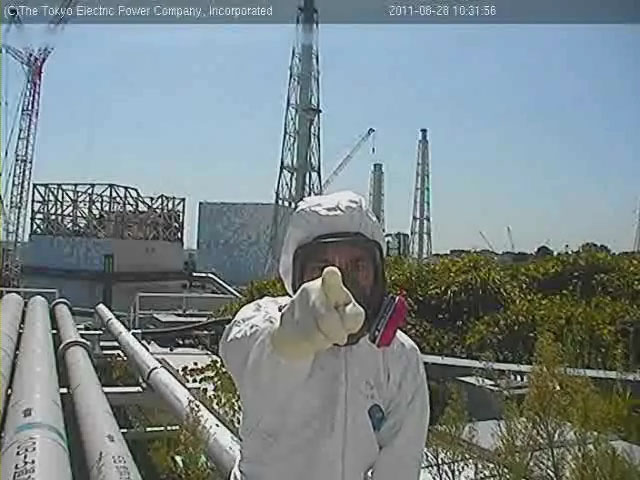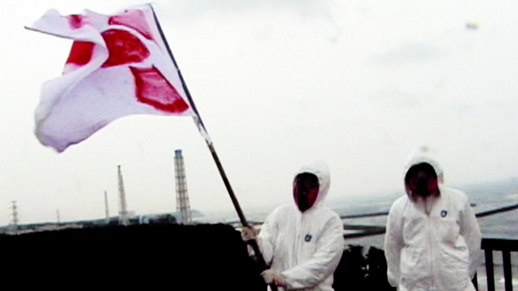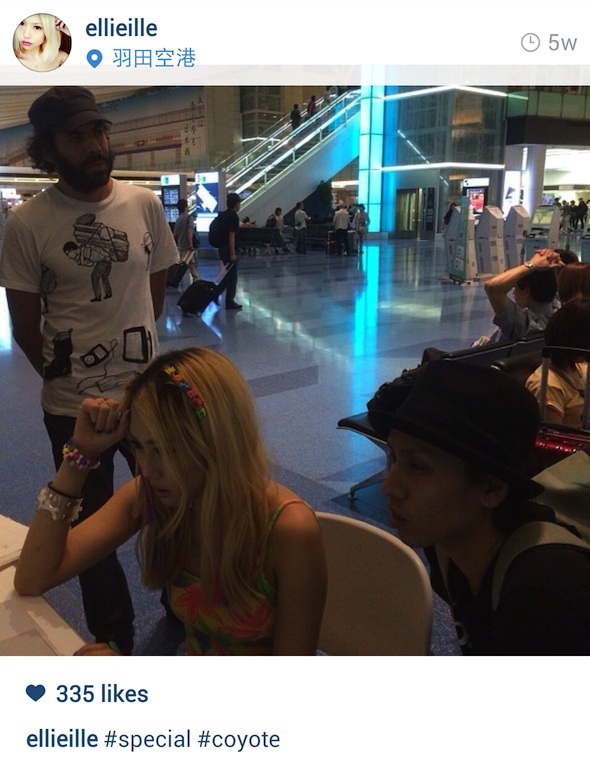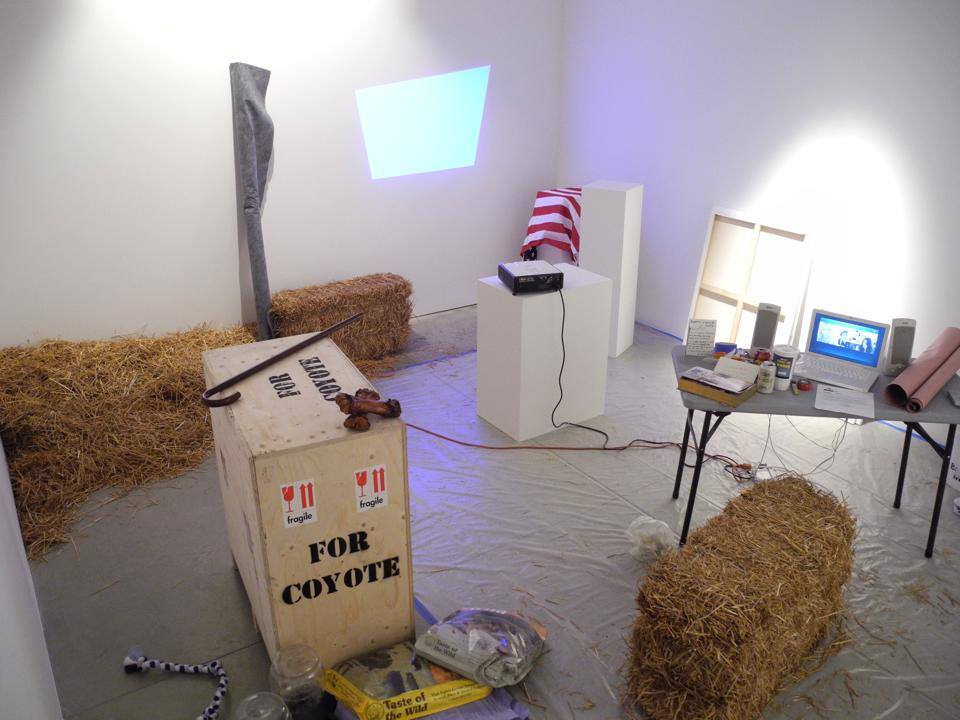
Finger Pointing Worker; video still of performance by Kota Takeuchi.
In the three years since a 9.0 magnitude earthquake tore apart infrastructures and livelihoods throughout eastern Japan, there's been a surge of international interest in any sign of the island country's recuperation. But Japan is no stranger to the process of recovery; its historical timeline is fractured by a variety of disasters. In the last hundred years alone, there were more than 40 recorded earthquakes which surpassed a 6.0 reading on the Richter scale, in addition to 6 major military operations.
This component of Japan's past is unfortunately, and often, mistaken as a component of Japanese identity in part because of its recurrence in national art and pop culture. Katsushika Hokusai's The Great Wave (c. 1833), a painting that depicts a frothing tsunami wave in the process of swallowing a row boat, is arguably the most recognizable piece of Japanese fine art. In another medium, and arriving nearly 100 years later, is Ishiro Honda's Godzilla (1954), the monster cinema star often understood as a metaphor for the Hiroshima and Nagasaki bombings. Because of their central quality of immense power and their appearance alongside Japanese disasters, both of these works are often regarded by the Western world as reflections on the peculiarities of Japan's geological and political timeline, yet rarely as explorations of the kind of natural and man-made events any country is liable to experience at any moment. (Especially significant is the fact that both "Tsunami" and "Godzilla" are Japanese words, transliterated to English only from their kanji and ateji phoneticizations, respectively).

Still from Ishiro Honda's Godzilla (1954).
In 2011, after the tripartite shockwave, tsunami, and nuclear reactor meltdown now known as the Fukushima disaster, a new international figure walked into the frame of Japanese artistic identity. Although not as popular as these two preceding examples, he's known as the Finger Pointing Worker.
Following the meltdown at the Fukushima Daiichi Nuclear Power Plant, its operator, Tokyo Electric Power Company (TEPCO), installed cameras throughout the compromised area in an attempt to transmit live feeds of the cleanup effort to viewers online. During one of these transmissions, someone dressed in a hazmat suit approached a camera, pointed an accusatory finger at its lens, and held this stance, motionless, for nearly 15 minutes. Recordings of the live feed eventually went viral in Japan, and inspired both domestic and international press to speculate who the worker was, and what his intentions were.
Using yet another Japanese tragedy as its backdrop, Finger Pointing Worker (which turned out to be a performance piece by Japanese artist and temporary Fukushima clean-up volunteer Kota Takeuchi) may only encourage Western audiences to continue commenting on the crisis-art culture of Japan. Just a few months ago, veteran art critic John McDonald used Takeuchi's piece as the foundation for his rather incendiary reflection on the politics of Fukushima and Japanese art, which starts with the blanket claim that "[d]isaster haunts the Japanese psyche."
But to focus on the piece's immediate context more than its comment or medium is to use it as a lens for rubbernecking. It is to miss the fact that Finger Pointing Worker is part of a bloom of young, contemporary Japanese artists who've developed a lust for performance art that doubles as political intervention. Like Takeuchi's performance, these artists share a collective dissatisfaction with the Japanese government—who many believe were decidedly underwhelming in their immediate response to the 2011 crises—and a non-violent aggression towards humanity's disavowal of nature. Fukushima, to them, is a point of utmost concern, but not necessarily a final port-of-call.

Still from Chim↑Pom's REAL TIMES.
Takeuchi's performance is one of the most illustrative of this fresh league's MO, but the Japanese art collective Chim↑Pom is arguably the most internationally known. In April 2011, just barely a month after the tsunami hit, Chim↑Pom's members, each dressed in hazmat suits (some authentic, some makeshift), trespassed into high-security areas around the Daiichi nuclear plant and hiked across fractured earth and roads towards a lookout point above the Pacific Ocean. Once at the peak, and with the still-smoldering reactors within clear view, the collective planted a white flag into the ground. The flag was initially unmarked, but before they hoisted it onto its pole, Chim↑Pom spray painted a red circle in its middle to imitate the Japanese national flag, and then added three demarcations around the circle, to turn it into the universal symbol for nuclear radiation. Footage of this action is included in a video entitled REAL TIMES, which will be shown at MoMA PS1 in New York City later this year and has been featured by major news outlets like CNN and PBS.
Chim↑Pom's leader, Ushiro Ryuta, visited New York a few weeks ago to oversee an installation by his group at the Friedman Benda gallery in Chelsea. The installation is part of a group showing of Japanese artists, entitled "Duality Of Existence - PostFukushima." When I arrived at the gallery, he was standing on a ladder in the middle of a narrow entryway, elevated between a few paintings by Kazuki Umezawa, taking photos of a room I couldn't see from my vantage point. We'd agreed to meet up and discuss the recent conflux of young performance artists in Japan, and to unpack the habit of associating their work with a national identity defined by widespread tragedy—as if being Japanese and experiencing disaster was necessitated by some phantom contract.
With these concepts looming over our meeting, it was a perfect coincidence that the exhibition was subtitled "PostFukushima." Before arriving, I was excited by the fantasy of glimpsing a nascent movement; if post-modernism was theorized, by some, as partly a response to World War II, it didn't feel far-fetched to assume there had already been a successful effort to gather Japanese works which exemplify an emerging post-Fukushima consciousness.
But this wasn't necessarily the case. Chim↑Pom's installation had absolutely nothing to do with Fukushima, and Ryuta was the first person to admit it. Inside the room he was photographing, I came to find disheveled bales of hay randomly placed throughout, a crate with "For Coyote" spray-painted across its front, a projector, and a laptop on a folding table looping a recorded Skype conversation between Ellie, one of Chim↑Pom's members, and one of the gallery's employees. It was a nod to Joseph Beuys's 1974 performance piece I Like America and America Likes Me, in which he shared a room at René Block Gallery with a coyote for three days, but in this case, Chim↑Pom's "coyote" referred to those who smuggle people across borders. Ellie, it turns out, was prohibited from entering the United States because she arrived on US soil with someone already blacklisted from the country. During our meeting, she was traveling throughout Mexico.

Bad day at the airport. via Ellie's Instagram.
I asked him and Kentaro Ikegami, our translator and one of Chim↑Pom's collaborators, what exactly was going on.
Why was this installation chosen for a "post-Fukushima" exhibition?
We had no idea that the theme was post-Fukushima. When the press release came out, we were like "oh, shit!" Originally the curator told us it was called "Duality of Existence," and was about physical realities in relation to post-internet realities. But we didn't know about it being "post-Fukushima" until the press release came out.
How do you feel about that?
We just want an opportunity to do the piece on account of Ellie's situation, because we thought this was the most interesting thing we could do. Her situation is more of a pressing matter to us than doing something cohesively with the other artists.
Fukushima is just part of our art. We're usually identified as using "Fukushima" and "Hiroshima" as main talking points, but we're only doing what we want to do at a given time. We are mostly driven by what we consider to be pressing issues of our time, such as Ellie's immigration issue. Regardless, we do see all our topics as inter-related and not isolated within those issues.
If you really look at the other installations in this exhibit, they don't look like they're about Fukushima at all. We don't think most artists knew about this.
But that makes me curious, because there have been a number of Fukushima-related exhibitions that you've been a part in. Like recently, at the National Museum of Modern Art, Tokyo you participated in an exhibition called "After The Quake: Thinking About Tohoku III."
Well, at least for this, I don't think most of the art here has to do with Fukushima as a departure point. It's almost an ad-libbed group showing. There are only a few works here that were actually made afterFukushima. A lot of those, like [Takahiro] Iwasaki's pieces, were started or originated before Fukushima. [The exhibition includes Iwasaki's Reflection Models (2014), a series of miniature recreations of Japanese temples joined with their reflections; the related work Reflection Model (Perfect Bliss) was begun in 2010. - Ed. ]
They clearly have used the phrase "post-Fukushima" as a way to be taken seriously. But we're not upset about it. We're not angry.
A lot of local residents in Fukushima, however, are pissed off by that kind of treatment of Fukushima. When people who weren't affected by the tragedy use it as a topic for their own benefit or cause... I'm sure a lot of New Yorkers felt that way about 9/11.
Even then, and maybe this was happening at the time, I rarely see art in America classified as "post-9/11." Inspired by 9/11, sure, but never with the nomenclature that implies a collective movement. When I feel like I've seen, especially this year, international museums and galleries hosting exhibitions beneath the banner of Fukushima when all that really means is "Japanese artists."
I agree with that observation. Although we don't want to make a category of "post-9/11," we too were unconsciously and politically implicated by that event. We think many artists feel that way even if they aren't explicitly categorized as such.
But there has to be a post-Fukushima set of artists. They just haven't been well organized yet. We don't think that category is actually useful, but regardless we think there has been a shift in artists' geist,and that cannot be ignored. Much like what happened everywhere after 9-11.

Takahiro Iwasaki Reflection Models (2014). Image: Friedman Benda Gallery.
When asked to outline who he considered a post-Fukushima artist, Ryuta told me about another collective, Kyun-Chome, who won one of Japan's most coveted art recognitions, the Taro Okamoto Award for Contemporary Art, in February this year. Kyun-Chome's portfolio parallels Chim↑Pom's in a number of ways: performance pieces staged and recorded in restricted areas around Fukushima, interactive gallery installations which temper with Japanese paradigms and cultural taboos, and the central focus on a female character, an "Ellie," who appears at the forefront of most of their video pieces staged after 2011. These similarities weren't surprising, however, considering Ryuta also said that Kyun-Chome were previous apprentices of Chim↑Pom's.
The most common thread throughout both collectives is a mischievous, sometimes playful interpretation of dire circumstances, which blurs cultural boundaries and strikes at political institutions. But is that what comprises the post-Fukushima ethos that Ryuta said has to exist?
You said that post-Fukushima artists have to exist. What makes Japan's post-Fukushima reality different from pre-Fukushima reality?
In Japan, grassroots things have changed, like protests, and demonstrations—overall, the conscience of young people. High schoolers of 2011, who were helpless to do anything, and who couldn't do much of anything because of their youth—that frustration, I think, will lead to a great change in the coming years.
Politically, though, nothing has changed.
But specifically in regards to Japanese art, are there any changes you've noticed at all, which you would attribute to Fukushima?
Domestically—although it's not represented by this exhibition—art has changed since 2011. For example, Mr. [Motohiko] Odani was rather well-known before, but he told me (Ryuta) that after March 11th, he couldn't produce anymore. He froze, he said, because he was in a state of chaos. I think something changed within him. That's not exclusive to Mr. Odani, though. It was a feeling shared by most Japanese artists.
Overall, there's this feeling that contemporary art is powerless and there's nothing it can do. But in response to that, there's this notion of "So what?" We have to do something. Many young Japanese artists are taking that "so what?" approach.
Is that how you'd describe post-Fukushima art? Art that takes that "So what?" approach?
Yes. I think it's important to make clear that art is physically powerless in the wake of an enormous disaster. Of course, it can't rescue lives; you can't eat it. But so what? Does that mean we should do nothing? That's what I mean by "so what." This just levels any assumption that it has power.
Ultimately though we couldn't really give a correct definition of post-Fukushima right now. It's very difficult. It's very early. But we think that young artists today know the powerlessness, yet still keep going because if we stop, it truly means we are powerless.
The important thing is not to victimize the situation, or to make it seem like Fukushima is a wound, or a departure point.
Yes. Not a wound, and no victimization.
The fact that Chim↑Pom weren't initially told about this exhibition's Fukushima slant stuck with me long after our conversation. While Ryuta acknowledged that there is a young spring of "post-Fukushima" art welling up in Japan, it seemed that the gallery's invocation of Fukushima was disconnected from his perception of its role in Chim↑Pom's work. Subtitling the exhibition "Post Fukushima" was therefore evidence of the same Western misconception that inspires the blanket claim that all Japan is haunted by past tragedy, and the very incarnation of what Ryuta did not want: Fukushima seen as something crippling, a hole that every facet of contemporary Japanese society had yet to climb out of.
But without Friedman Benda being aware of it, including Chim↑Pom's homage to Ellie's visa troubles in an exhibition intended to showcase the aftermath of Fukushima also undermined this fallacy. Their work pointed to the fact that contemporary Japanese art, with its preoccupation with performance, intervention, and political critique, addresses a range of concerns that include but do not end with Fukushima.

Chim↑Pom's installation at the Friedman Benda gallery. Image: Friedman Benda Gallery.
Chim↑Pom's work, like Honda's giant lizard, and Hokusai's wave, and Takeuchi's veiled worker, gained international praise due to its ability to turn a gaping local disaster into a universally relatable experience, only to be pigeonholed as quintessentially, tragically Japanese. In fact, Chim↑Pom's work is most valuable not as a response to a specific event, but as a powerful statement in favor of taking action in the face of seemingly unalterable conditions. Specifically, one part of Chim↑Pom's REAL TIMES piece comes to mind, in which the collective stands among ruins with youth from the crippled city of Soma, and shouts 100 ki-ai, an almost spiritual martial arts chant, to bring life back to an otherwise lifeless scene. Like all of Chim↑Pom's work, it twists the face of an event so many outsiders still refer to like a nation's coffin.
What makes these young artists salient, and what makes the international and domestic spotlight still interested in their work three years after Fukushima, is their universal implications. They elicit a reminder that these types of widespread destruction are not merely plausible, and not merely Japanese, but nascent and actual and generalizable; they have the power to turn the land of even the most developed economic powers into ruins. The Japanese are not the only people aware that nature can be destructive, but much like the erstwhile residents of Chernobyl, they are some of the only samplings of people who've really seen how careless environmental management can rob any terrain of its life, even for decades after. Because of this, it's actually more logical to analyze Japanese contemporary artists in terms of their resilience and resolve, and not in the coincidence of living near the Pacific Ocean's Ring of Fire.
During our dinner together that night, and at the cusp of extinguishing our hours-long conversation on the subject, Ikegami reflected on the power of language. "Disasters create art," he said. "Fukushima is very strange, but it's not domestic. In the same way Chernobyl was also a global problem. But it's funny that it is called the 'Fukushima' nuclear accident. Not the 'Pacific Ocean' nuclear accident. Not the 'TEPCO' nuclear accident." By uniting its name with the disaster, the location, it seems, gets branded with that irreducible stigma we'd been dissecting in the gallery. It made me wonder how successful the Godzilla franchise would have been in the United States if its name were simply a direct translation from the word's origin "daikaiju": Giant Monster.
But what younger groups like Chim↑Pom and Kyun-Chome are doing is much larger than Hollywood, or Tokyo, or any specific locale in between. It's the towering statement that tragedy may seem to render art obsolete and nullify political agency, but never indelibly—or if it does, there is still strength to be found in making art and taking political action. In other words: so what?
Johnny Magdaleno is a writer and freelance journalist based in New York. He frequently contributes to VICE, T: The New York Times Style Magazine, and other publications. You can follow him on Twitter @johnny_mgdlno.

